How these funds are to be spent and by whom will be determined later, in consultation with Indigenous leaders, also to be determined later. The desire now is for an opportunity to do something quickly, and nothing is quicker than writing a cheque.
Given the prevalence of confusing public conversation about residential schools, it might be helpful for Catholics to recall what has already been done in terms of financial compensation.
The Indian Residential Schools Settlement Agreement (IRSSA) was signed in 2006 by the victims joining a class action, the federal government, the involved churches and Indigenous leadership.
Under the IRSSA, the federal government, the primary actor in the residential schools policy, offered $1.9 billion in compensation to every former student.
There was also an “Independent Assessment Process” for those who had suffered further abuse in the schools. An additional $1.7 billion was paid from that fund.
The federal government, scrambling to recover from its lethargy on the residential schools file, just last month announced that day-school (non-residential) students would also receive a minimum $10,000 common experience payment.
What about the Catholic Church? As there is no legal entity that is the Catholic Church in Canada, but rather a collection of legally independent dioceses, religious orders, hospitals, educational and social service institutions, a group called “Catholic Entities” was assembled to be party to the IRSSA.
The Catholic Entities made three commitments. The first was a cash payment of $29 million for healing programs that would be run by First Nations themselves. The second was a commitment to provide $25 million in in-kind services to victims and Indigenous communities. The third was a commitment to make “best efforts” to raise a further $25 million.
What happened to those three commitments? Were the Catholic Entities delinquent, as seems to be widely believed?
In 2015, the Catholic Entities and the federal government disagreed on whether the first commitment of $29 million had been met. Arbitration in a Saskatchewan court ruled that final payment of $1.2 million was owed, so the Catholic Entities paid that money and the judge ruled that all their financial obligations had been met.
The second commitment required the Catholic Entities to provide $25 million of in-kind health, well-being and community services between 2007 and 2017. By 2014, the Catholic Entities had delivered nearly $30 million to community-based projects. Those services continued after 2014, even though the legal commitment had already been met.
The third commitment was the “best efforts” fundraising campaign.
What exactly was done? In 2006 the Catholic Entities launched their “Moving Forward” campaign to raise the $25 million. The chairman of the campaign was Phil Fontaine, the former chief of the Assembly of First Nations who had brought the residential schools to broad public awareness in the 1980s and 1990s.
The campaign engaged the services of Ketchum Philanthropy, one the leading fundraisers for Canadian universities and hospitals. The campaign approached the large donors required to launch a broader appeal to smaller donors. There was little interest. There are many ostentatious commitments to reconciliation heard now, when the issue is in the headlines. Fifteen years ago, when the fundraising campaign was underway, there were few takers.
After seven years, and having spent $2 million (which would be standard if the campaign had indeed raised $25 million) with little to show in return, Moving Forward dismissed the professional fundraisers and decided to hold a special national collection across the country. It was taken up in parishes on Dec. 8, 2013, including in dioceses which never operated residential schools.
In the end, the Catholic Entities maintain that they did what the committed to do, make their “best efforts”. They raised $3.7 million, not $25 million. Why did the fundraising campaign fail to meet its goal?
Catholics in Canada today are not what they were 50 years ago. The great religious orders are more dead than alive, and the Irish and French heritage of the Church is similarly dwindling. The energy in the Catholic Church in Canada today is with immigrant groups and new movements, with roots in Canada of only a few generations. How do they look upon the residential schools when they weren’t even in Canada at the time they were operating?
The failure of the fundraising campaign arises also from the lack of confidence many Canadians have in the competence of the government, both federally and in Indigenous communities, to get good results for the money spent.
Perhaps Catholic fundraising activities will manage to meet the original $25 million goal, or even exceed it. That amount of money may do some good, though only at the margins, given the more than the $4 billion already spent. For point of comparison, in January 2020 the federal government announced $200 million in funding for “Legacy Projects” related to residential schools, and in June 2021 announced $50 million to fund the new Day Scholar Revitalization Society.
Catholic fundraising efforts will not approach those figures. Yet the point is not the money raised, but the symbolic action taken.
(Fr. de Souza is the founding editor of Convivium and a pastor in the Archdiocese of Kingston.)


